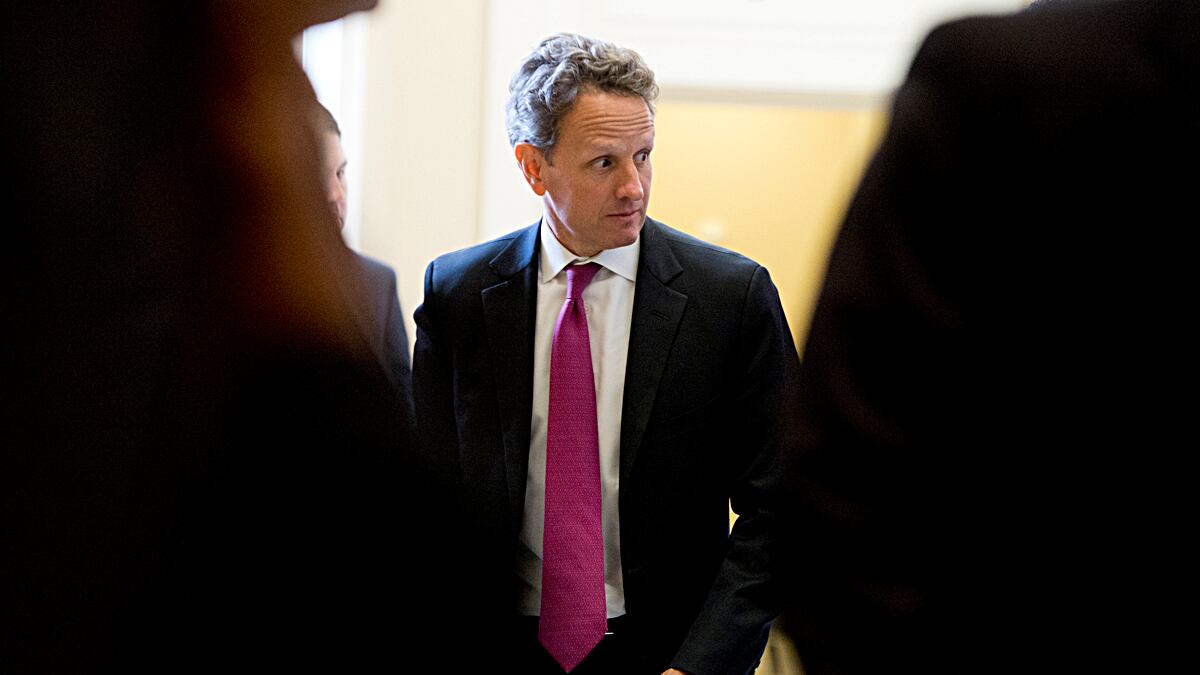
From August 2007 to October 2008, the Federal Reserve received mounting evidence of manipulation of LIBOR, the international interest rates that underpin hundreds of trillions of dollars in assets around the world, according to documents released today by the New York Federal Reserve.
During that period, internal emails, phone transcripts, and presentation slides—some shared with Barclays Bank itself—all provided American authorities with convincing evidence that the crucial numbers were being manipulated. As suspicion grew in early 2008, the concerns made it to the desk of Tim Geithner, then president of the New York Fed, and then all the way up to the Treasury Department.
Still, U.S. authorities did not initiate a public plan to fix the LIBOR misreporting—nor did it inform the markets that their trillions in LIBOR-indexed assets were being manipulated.
The documents, which were requested by Congress, illustrate the growing American role in the international financial scandal. British and American regulators have already fined Barclays $453 million for lying in order to manipulate interest rates. Fifteen other banks are currently under investigation for the same crime.
LIBOR is one of the most important numbers in the global economy, underpinning $550 trillion in derivatives, and affecting the value of 80% of American mortgage and commercial loans.
Although the scandal only recently hit the headlines, the newly released documents show that the New York Fed received its first direct tip of the manipulation as early as August 28, 2007, in the form of a “reply-all” to a “mass-distribution email from Barclays.”
“Today’s [U.S. dollar] libors have come out and they look too low to me,” a Barclays employee wrote, indicating suspicion that the banks were influencing the rate. “Draw your own conclusions about why people are going for unrealistically low libors,” the employee added.
On September 3, as credit dried up amid the financial crisis, a Barclays employee emailed the New York Fed complaining that “Libors continue to be set too low.”
Within months, American financial regulators were regularly discussing unusual LIBOR rates with their British counterparts—and with Barclays itself. In early 2008, Geithner discussed the issue personally with Bank of England governor Mervyn King in Basel, Switzerland, according to email correspondence between the two exchanged later that year. By 2008, the United States Treasury Department had been briefed on potential LIBOR manipulation.
Some of the evidence in the documents was particularly stark. On April 11, 2008, New York Fed officials contacted Barclays employees about their concerns regarding LIBOR. In a transcript of that telephone conversation, an unidentified Barclays employee told Fed official Fabiola Ravazzolo, “We know that we’re not posting, um, an honest LIBOR.”
Experts have argued that Geithner would have had more than enough power to curb the manipulation, or to refer it to the Justice Department and Commodity Futures Trading Commission. For example, the New York Fed, which was already engaged in rescuing the banks during the 2008 financial crisis, could have “jawboned” them and pressured them to fix the reporting scheme.
Throughout 2008, the evidence continued to mount.
On April 11, the Fed circulated a report confirming that “our contacts at LIBOR-contributing banks have indicated a tendency to under-report actual borrowing costs.”
Yet on May 20, the Fed circulated another, seemingly contradictory internal report which stated, “Beyond the anecdotal evidence and LIBOR re-sets, it is difficult to find convincing evidence of actual misreporting.”
Even despite the May 20 report, the LIBOR suspicions were deemed sufficiently serious that on June 1, Geithner emailed King with “recommendations” on how to save the rate. He advised the governor to “establish a credible reporting procedure” and “eliminate incentive[s] to misreport,” and asked him to “give us some sense of what changes are possible.”
In Britain, the newly released documents—requested by the U.S. Congress—raise awkward questions for deputy Bank of England governor Paul Tucker. In recent testimony, Tucker claimed that in 2008 he was only “part of the discussion in broad terms” when it came to the rate fixing.
But on June 3 of that year, King told Geithner that he had asked Tucker follow up on his recommendations, according to their personal correspondence. And on the same day, according to just-released Bank of England correspondence, Tucker discussed the recommendations with Angela Knight, head of the British Bankers Association.
“Changes are being made to incorporate the views of the Fed,” Knight told Tucker in an email. “There is no show stopper as far as we can see.”
Eight months earlier, Tucker told a meeting of British financial officials that “the Bank [of England] would consider seriously the suggestions” of addressing “Libor fixings,” according to Bank of England minutes from the Nov. 15, 2007, meeting.
Back in the United States, as early as May 2008 the New York Fed was sharing its concerns with high-level financial authorities, including the Fed’s Board of Governors, the President’s Working Group on Financial Markets, and the Treasury Department. But the widening and troubling spreads between LIBOR rates and Overnight Index Swap rates (another benchmark risk indicator) continued to be attributed mostly to “credit concerns.” In one presentation, “allegations of misreporting” were deemed “difficult to evaluate.”
Instead, the New York Fed blamed most LIBOR problems on banks’ fear of being caught out of the pack. Since LIBOR submissions are public and indicate a bank’s borrowing costs, sending in numbers that are higher than everyone else’s can expose you to speculative attacks. In short, the Fed focused on the banks’ desire to protect themselves—not on their desire for profit.
But this theory was challenged by a much-cited 2010 study which presented quantitative evidence that the unusual LIBOR submissions showed that “misreporting incentives are partially driven by member bank portfolio positions”—that is, by their desire for trading gains.
That analysis would have been bolstered by an Oct. 24, 2008, phone call between a Fed official and a Barclays employee, in which the banker said, "The market so desperately wants LIBORs down it's actually putting wrong rates in.” He added that other traders were using LIBOR submissions to boost their yields. A banker from Chase New York, he said, was “trying to get himself a better rate on the dollar assets.
“I can’t blame him for doing it,” the bank employee said. “The market knows that you’re scared to put [LIBOR] where you really think it is. I mean, I know that I’m consistently high, but I think I’m consistently correct.”
In another call on Oct. 27, a Barclays employer told a Fed official that as early as the beginning of 2008, “people were saying, ‘Why are you setting your LIBORs so high?’”
But according to today’s document dump, questions about LIBOR were coming far sooner—and from far higher places—than that.






